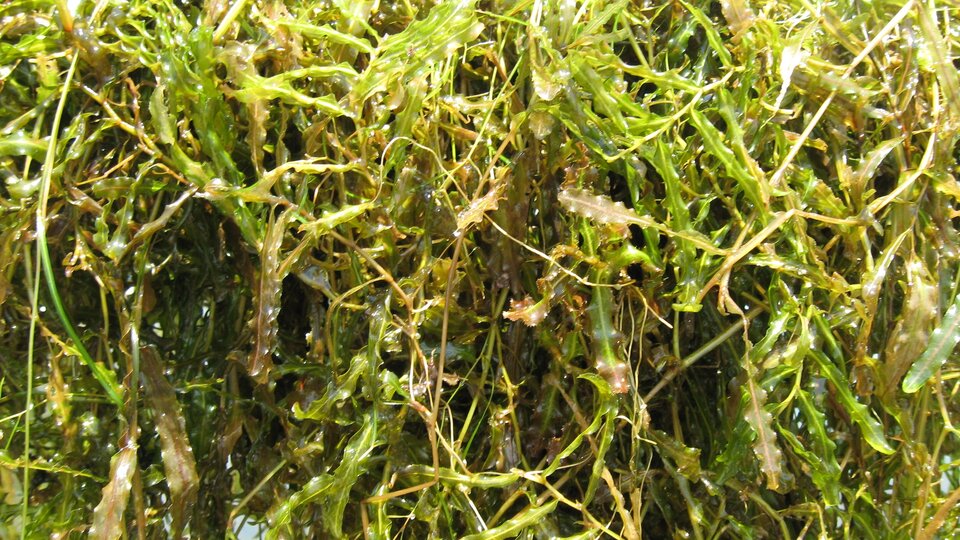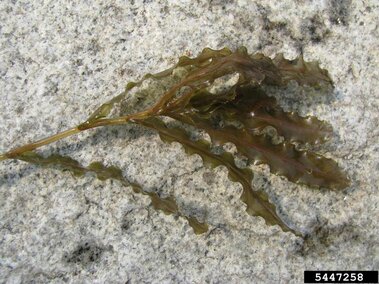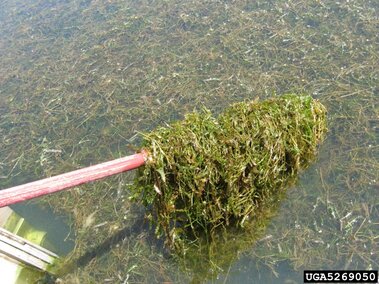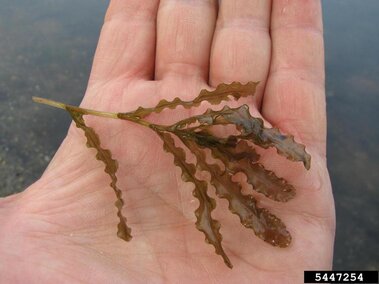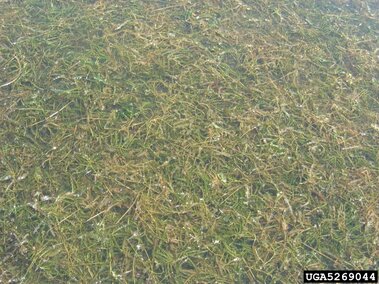General Information
Species Name: Potamogeton crispus
Also Known As: curly pondweed
Family: Potamogetonaceae (Pondweed)
Growth Form: Herb (submerged aquatic)
Life Span: Perennial
Flowering Dates: May-July
Origin: Eurasia, Africa, Australia
Noxious: No
Category 2: Priority Aquatic Invasive Species
Why Is It Invasive?
Curly-leaf pondweed is highly invasive, at its worst forming dense monocultures that impede water flow, impair recreational activites, degrade or destroy fish habitat, crowd out native aquatic plants, and can impact waterfront property values. When it dies back in mid-summer it releases large amounts of phosphorus, feeding algae blooms and sucking oxygen from the water, potentially impairing fish populations and drinking water quality.
What Does It Look Like?
General Characteristics
Curly-leaf pondweed is a rooted, submersed aquatic plant. Its coloration varies from olive-green to reddish-brown.
Flowers
Flowering occurs in the summer to early fall, when emergent flowers develop. The flower stalk grows up above the water surface. Flowers grow to about one inch tall, are inconspicuous, and appear reddish-brown in the water but are actually green when examined closely.
Leaves
Leaves are sessile, oblong, stiff, 1.6-3.9 in. (4-10 cm) long, 0.2-0.4 in. (5-10 mm) wide, translucent and have noticeably curly margins (resemble lasagna noodles). Leaves are arranged alternately, are directly attached to the stem, and become denser toward the end of the stem.
Stems
The main stem can be various colors including white, green, brown, and red, and tends to branch multiple times near the top of the plant. Rhizomes (an underground stem that sends out roots and shoots from its nodes) are thick and pale yellow in color. Many stems can be connected by one rhizome.
Seeds
Fruits are flat with a pointed beak and are 0.16-0.24 in. (4-6 mm) long. The seed do not seem to be viable. In the midsummer plants form turions (vegetative buds), from which new growth starts in fall or winter. Reproductive structures are called turions. They are brown, typically a half-inch in size and look like sharp small pinecones. It can also reproduce via seed, but seeds play a small role in reproduction.
Photos
Where Does It Grow?
It grows in shallow to deep, still or flowing water and is tolerant of disturbance. It was likely introduced when common carp were intentionally introduced into Midwest waters as a game fish in the 1880s. The species was likely spread through the movement of watercraft and water-related equipment.
How Does It Spread?
People spread curly-leaf pondweed primarily through the movement of water-related equipment. Plant fragments and turions can get stuck on trailers, motors, docks, boat lifts, swim rafts and inside watercraft (boats, canoes and kayaks). Turions, which may be hidden in mud and debris, can stick to anchors as well as scuba, fishing, and hunting gear.
How Do I Control It?
Contact the Nebraska Game and Parks Commission for more information.
Mechanical
Cutting or pulling the plant by hand or with equipment such as rakes or cutting blades could break it into fragments, allowing it to further spread. Contact the Nebraska Game and Parks Commission to determine appropriate removal methods.
Cultural
CLEAN your watercraft, trailer, angling gear and other equipment. Remove all aquatic vegetation and animal species from your equipment.
DRAIN your watercraft at the ramp by removing the boat plug and draining all live wells and ballast tanks.
DRY your watercraft, trailer and other equipment for at least 7 days before visiting another waterbody.
Chemical
Contact the Nebraska Game and Parks Commission for more information.
What Should I Do If I See It in Nebraska?
If you see curly-leaf pondweed in Nebraska, you should report it to the Nebraska Game and Parks Commission's Aquatic Invasive Species (AIS) Program using their AIS Report Form. For guidance on what information to include in your report, check out our reporting tips.
References and More Information
California Invasive Plant Council
Center for Invasive Species and Ecosystem Health
Minnesota Department of Natural Resources
National Invasive Species Information Center
Nebraska Game and Parks Commission
Texas Invasive Species Institute
U.S. Fish & Wildlife Service Ecological Screening Summary
USGS Nonindigenous Aquatic Species
